
Down to Earth
Organic gardener, Sue Woodd, has been composting waste and garden thinnings for many years. I had the enormous pleasure of working with Sue and husband, Hugh, when they moved into their one-third acre plot in Winchester a few years ago. I asked Sue to share her tips for getting the most out of our compost heaps:
“These are a few rules to keep in mind:
“We have 3 different composters in the garden: the wooden bin at the bottom of the garden, a plastic bin near the kitchen, and a tumbler in a sunny spot. “Once a year, on a fine spring day, we bag up the finished compost (which was covered over winter to ‘brew’). We then restart the process, incorporating any poor quality, unfinished bits for next year's heap. All ingredients go straight in but I either chop or shred bulky waste, and try to layer with grass or kitchen waste and, occasionally, manure. “I add a maximum of 2 bags of grass at a time (the rest goes into the other composters or is used as mulch in the garden). I keep a bag of wood ash for occasional use. Cardboard sits around to get damp ready to rip up, and we use the pee-pot from time to time. “The tumbler works well with the same ingredients, but has done much better since I moved it into the sun. There’s no need to worry about layering as the contents get churned up anyway. This method is limited by the weight I can turn and usually produces 2 lots of compost a year, although it could do more. “The plastic bin is the least successful, even though the worms love it! We have to lift off the bin (a difficult job), bag up the good compost at the bottom and return the rest to the bin once we’ve put it back. “Apart from general garden use, I use my compost in a 50% mix with spent compost, plus added seaweed meal for tomatoes and other vegetables in pots. Full article at: www.thegrowingcompany.co.uk/tips_on_composting.html
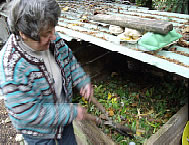 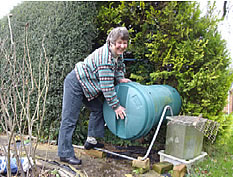
^ Heaps of Fun - Sue demonstrates the tumbling compost bin and how to layer material in the wooden bin.
I Say Tomato…
As you’ll know from an earlier edition of The Mulch, I grew six tomato plants from seed this year, according to biodynamic principles (sowing them at the ‘right time’). I then selected the three strongest seedlings from this group and three from the batch that were sown at the ‘wrong time’ and planted them up in growbags at the same time. Interestingly, the group sown at the ‘right time’, were further ahead in growth than the other group even though they were younger plants (sown six days later). During the dismal summer, both groups seemed to grow at about the same rate, the control group eventually catching up towards late August. Fruit ripened evenly on both groups, although the plants grown at the ‘right time’ suffered less from green top and splitting (erratic watering at times). Taste-wise, both produced sweet and delicious fruit. For me, I’d say that there’s a positive difference in the germination and early growing stages in sowing and planting biodynamically. After that, there may not be as much of a difference. One things for sure, though. I’m going to try again next year with different crops! For more information: www.biodynamic.org.uk
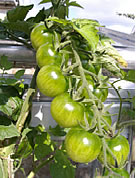 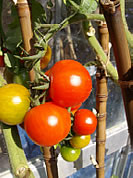 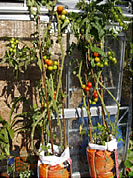
^ Take it as red, The right hand grow bag contains the plants sown at the ‘right time’.
Kerb Appeal
Thinking of creating (or replacing) a hard standing area in your front garden larger than 5 square metres? On 1 October 2008, the Government introduced rules making the hard surfacing of parking areas, drives and hard standings in domestic front gardens permitted development only where the surface is made permeable. If a new driveway or parking area is constructed using permeable surfaces (e.g. porous asphalt, permeable concrete block paving or gravel), or if the water is otherwise able to soak into the ground on the property, you will not require planning permission. Use of traditional materials (for example, impermeable concrete, tarmac, paving slabs with mortar joints) where rainwater will run off to the road, requires an application for planning permission. www.communities.gov.uk/publications/planningandbuilding/pavingfrontgardens
Twists and Turns
Twists and Turns As part of the ‘Walk A Quiet Path’ project across Southampton in 2008, the Ropewalk Community Garden commissioned a rope-themed labyrinth in the autumn to encircle a metal feature in the middle of the play area.
The Ropewalk Labyrinth is a unique adaptation of the traditional seven-circuit Cretan labyrinth and weaves its way around a number of fixed features at the site, including a metal seat, drain and three metal fins.
Dee Brown from the Ropewalk Community Garden and Claire Townend from the Environment Centre and local young people helped to stencil the feature on the ground. It was completed in time for the annual Fun Day event and will be a permanent feature in the garden.
www.thegrowingcompany.co.uk/local_labyrinths.html
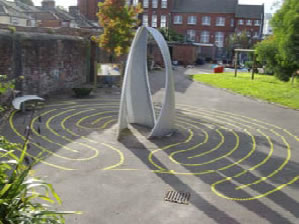 < Rope on a slope < Rope on a slope
This seven-circuit Cretan labyrinth
design was specially adapted to wrap around the features in the site.
Autumn’s Fiery Embers…
The end of November can be a difficult time to get right when it comes to planting design: a little too early for the winter-flowering shrubs and bulbs and a little late for the late summer flowering annuals, climbers and shrubs. The 9 examples below were photographed in my garden at the end of November and show that with a combination of luck, an autumn mild spell and a sheltered aspect, there can still be plenty of colour to brighten the mood at this time of year.
|
Clockwise from top left:
Cyclamen hederifolium,
Jasminum nudiflorum,
Viburnum tinus, Lobelia,
Verbena canadensis,
Tropaeolum majus,
Ricinus communis,
Lavatera x clementii,
Euonymus europea
|
|
|
|
|
|
|
Cuttings…
Times to Thrive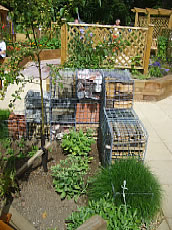
The horticultural therapy charity based at Trunkwell near Reading, is one of three charities to be supported by The Times Christmas 2008 Charity Appeal. www.thrive.org.uk
Pole-axed Over Illegal Logging
The EU has angered environmental groups by delaying a decision to ban illegally harvested wood being sold in member countries. As the biggest importer of timber in the world, this decision would have far-reaching effects on logging and timber industry practices but ferocious lobbying by pulp, paper and garden furniture industries seems to have pushed the decision back by months, if not years. The UK special envoy for forestry, Barry Gardiner, fears that the ban decision has been “fudged” and risks being abandoned altogether. In 2008, Greenpeace witnessed at least six cargo ships with illegal timber (from companies in the Amazon and the DR Congo) entering the EU. Deforestation accounts for 20% of all greenhouse gas emissions, more CO2 than is produced by all worldwide transport. www.greenpeace.org.uk/forests
Preservatives in a Jam
For several years, reports of chemical preservatives leaching out of treated timber and polluting the soil has worried consumers and prompted organic organisations to identify and promote more environmentally-friendly alternatives to outdoor timber products. The main problem seems to be the retention of a preservative called CCA (chrome, copper, arsenic chemical preservative) in timber. BS8417 specifies stringent conditions for the penetration, retention and fixation of CCA before sale. It is important to check for this British Standard and the stringent ‘Use Class 4’ (ensuring a service life of between 15 and 30 years for the timber) when ordering tanalised timber for deck, fencing or other outdoor timber structures. Log in and view the factsheet at: www.gardenorganic.org.uk/factsheets/gg33.php
Garden Commendation
Many congratulations to design and gardening clients, the Smith family in Bassett, for their Highly Commended award in the Best Private Garden – first time entry section of the 2008 Southampton in Bloom competition.
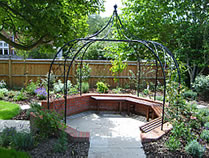 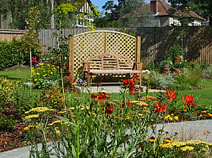
Mark Rendell
garden designer
____________________________________________________________
Imaginative and affordable design
and planting solutions for every kind of garden
www.thegrowingcompany.co.uk
printed version uses conservation grade recycled paper
|

